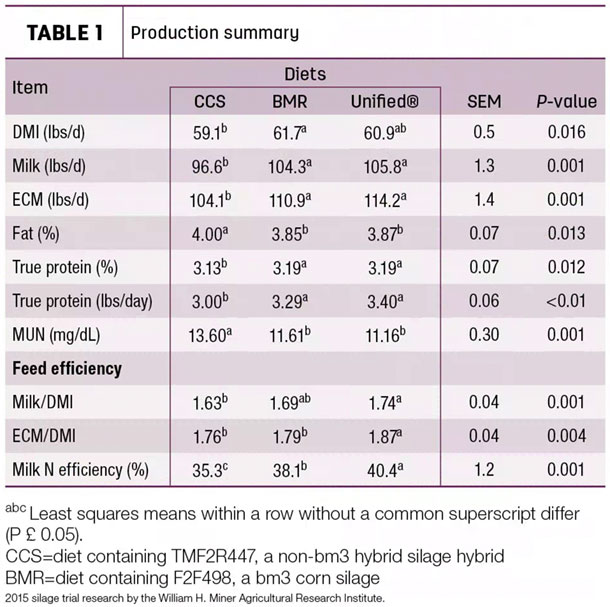Corn silage is the go-to homegrown forage for supplying digestible starch and fiber high-producing cows require. Often, however, shortcuts and oversights during the growing, harvest and storage processes can limit its resulting feed value.
Numerous studies have documented the importance of digestible starch to cow performance – results that can positively affect a dairy enterprise’s bottom line. University of Wisconsin research shows that improving total tract starch digestibility by just five points reduces supplemental corn grain feeding by 1.5 pounds – or 9 cents in feed costs – per cow per day. Those few pennies don’t seem like a lot, until you add them up. For 100 cows, it amounts to over $3,000 in feed savings in a year, plus reduced return in lost milk production.
It’s common knowledge that basic agronomic practices are essential first steps to ensuring healthy corn silage. Weed and disease control and strategic nitrogen applications can contribute to better corn silage starch development.
But maximizing digestible starch (starch-d) in corn silage doesn’t end with the growing season. The importance of full fermentation, particle size and plant moisture shouldn’t be overlooked. Before you harvest this fall, consider these avoidable mistakes that could limit your corn silage’s starch-d.
Mistake 1: Poor inventory control and inadequate carryover
Not having enough year-old corn silage to last until the newly chopped silage has fully fermented can be a costly mistake. As noted above, you’ll end up paying more than necessary to supplement the diet with the digestible starch high-producing cows require. Or milk income may drop as production suffers when new silage is fed before it’s fully fermented.
These scenarios are avoidable by having at least 120 days carryover corn silage. That costs money, but milk losses and increased diet costs are extremely expensive.
Conquering a carryover problem for next year begins right after this year’s harvest. Meet with your nutritionist and crops manager to determine future forage needs. If herd expansion is planned, that must be factored into the amount of corn silage you’ll plant next spring.
Evaluate your inventory and expected yield to carry you through the next 15 to 18 months. Remember, if you plant and harvest traditional corn silage hybrids next year, the crop will need to ferment several months to significantly improve starch digestibility. It should sit for at least four months before you feed it. Then this inventory must carry you through until the next crop year is ready to feed.
Another option and cost-effective solution for bridging an anticipated inventory gap next year is to grow corn silage with highly digestible starch. These hybrids can provide significantly improved levels of starch-d immediately after harvesting; although I recommend waiting 45 days until feeding to make sure the silage is stable.
These new hybrids combine the fiber digestibility of brown midrib hybrids with a softer, more digestible kernel. Research by the W.H. Miner Institute indicates these advanced hybrids provide increased energy-corrected milk, components and improved feed efficiencies. Discuss this option with your nutritionist or seed dealer to learn more about advanced corn silage hybrid choices now available.
Mistake 2: Lack of thorough kernel processing
Most producers know that kernel processing of corn silage is an economical way to make starch more rumenp-available in the dairy diet. Though kernel processing during harvest has improved on most farms in recent years, there’s still room for improvement.
To significantly improve starch-d, high-producing cows need to have kernels obliterated – not just nicked. University of Wisconsin research has shown a 15% improvement in rumen starch-d with a shredlage kernel processor over conventional rolls.
Aim for a minimum kernel processing score (KPS) of 60% or more on fresh samples, and seek higher, to ensure an optimum KPS of 70% or more, on well-fermented samples. Research indicates the KPS improves with time in fermentation by an average of 10 points.

Even though it will take longer to harvest and likely cost more, slowing the chopping rate to get this detail right will pay. University of Wisconsin research estimates a 5- to 10-unit gain in KPS may improve rumen starch digestion by the same amount. This easily equates to an added pound of milk per cow per day when feeding high-corn-silage diets. That’s about $6 additional milk per ton of corn silage harvested, or approximately $120 per acre.
Check kernel processing every hour or two – and each time harvesting shifts to a new field or different hybrid. Monitor for proper kernel processing throughout harvest by scooping up a quart of fresh silage and separating out all half and whole kernels. If you find more than four halves or two whole/nicked kernels, processing is inadequate. The chopper operator should adjust the roll gap and/or slow the harvest speed to achieve the targeted 60% or higher KPS.
If you’re working with a custom chopper, be sure to outline your KPS goal from the outset. Explain that you understand thorough kernel processing may require slowing chopping speed and that you’re willing to pay for the job to be done correctly. Even if the custom harvester must charge $2 to $3 per ton more for the KPS you desire, it’s worth the investment, especially as whole-plant moisture nears the drier end of the scale.
Mistake 3: Failing to closely monitor plant moisture
Chopping corn silage at the ideal maturity stage is a significant contributor to starch-d and volume.
Corn silage is normally chopped about six weeks after pollination or about 50% kernel milkline. So at four weeks after tasseling, begin scouting. Conduct a physical check of fields, stripping husks and looking for kernel dent. Scout every few days.
Once dent is present on most kernels and a kernel milkline is visible, chop some whole plants to measure moisture content.
Corn silage averages about a half-point moisture loss per day, but it can vary from 0 to 3 points due to plant maturity, soil moisture, temperature and wind. Remember, testing – rather than guessing based on appearance – is essential in determining accurate plant moisture.
For ideal fermentation and good starch availability, start chopping when whole-plant moisture reaches 68% for flat storage and slightly drier for uprights. You need to be ready to roll when the optimum moisture is identified, so prepare in advance by:
- Calculating the amount of time required to harvest the crop. Remember to factor in breakdowns and delays.
- Tuning up the chopper and replacing worn parts if needed. Have a backup processor and other critical parts on hand.
- Stocking up on inoculants and storage supplies.
- Conducting harvest training to ensure packers know proper procedures (with flat storage).
Maximizing the digestible starch available in your corn silage requires attention to detail at every stage – growing, harvesting and storage. Better management practices combined with exceptional hybrid genetics can ensure your high-producing cows are getting the energy they need from the corn silage you work so hard to produce.






